State of Latino Health: Dismal, and Invisible
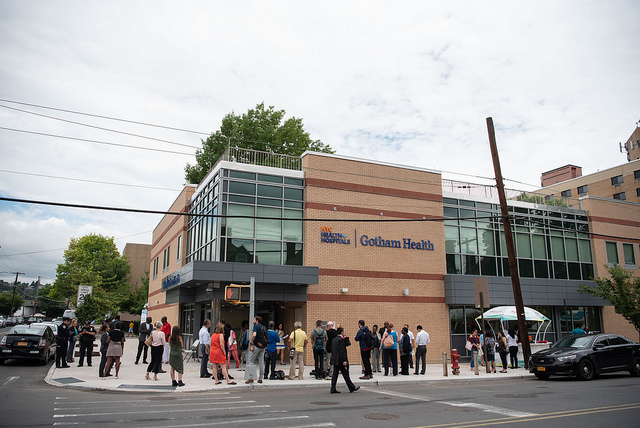
(photo via NYC Mayor's Office)
Latinos make up nearly a third of New York City’s eight million residents. But even though we are a large part of New York’s present and a rising population that’s crucial to the city’s future, we are completely invisible.
We are invisible in large part because we are different. And because of those joined factors, our health care is in a state of crisis. Compared to our fellow New York neighbors, we lack access to quality, culturally competent care, and we face a shortage of high-quality family care options. In fact, we sometimes encounter unique barriers that make us even more susceptible to illnesses than our neighbors and tend to experience worse health outcomes.
After decades of efforts to bring health care to underserved Latinos across the city, we set out to answer crucial questions: Why do great disparities in health care remain? And why do our families lack the health care services they need?
Why are Latinos far less healthy than our neighbors?
In a new report put out by my organization, a nonprofit network of over 2,000 providers who treat over 650,000 patients largely from lower income immigrant communities, we talked to hundreds of Latino doctors and patients across New York City to compile a first-ever poll.
We hope it spurs a movement.
We set out to bring to light health disparities and the cultural, economic, and institutional barriers that diminish access to even basic health care services -- leading to devastating health outcomes for many in our communities.
So what did we learn about the state of Latino health in New York City in 2018?
First, we learned that there is a wide gap between Latino patients and their physicians over what constitutes good health. While a majority of Latinos think they are healthy, their doctors disagree by vast margins. And only one-third of Latino patients think they are not receiving the care they need while two-thirds of doctors think Latinos experience persistent barriers to care.
Second, transportation and child care pose major barriers to health care access in Latino communities. Language is another major issue: in the Bronx, home to the city’s largest Latino population, only 10% of doctors speak Spanish, compared to 60% of residents. In fact, immigrants interviewed stated that language barriers kept them from telling their health care providers all of their symptoms – leading to unnecessary emergency room visits, avoidable crises, and uncontrolled chronic conditions.
Finally, too many health problems are going untreated in the Latino community. Smoking, asthma, obesity, diabetes, and hypertension are prevalent problems but health education has not kept up and health education materials are often not available in Spanish. In addition, mental health and substance abuse challenges are stigmatized and remain taboo to discuss, going undertreated or even untreated.
In short, our report showed us that we have much more work to do to lift up and improve health outcomes in the Latino community, but we can make progress if we are willing to put in the work.
Together, by prioritizing community engagement, we can build and scale a sustainable architecture of innovation to confront and solve these problems. We can and must develop and sustain strong community, public health, and health care strategies to improve access to quality, culturally competent, and much needed care.
Additionally, we also need a serious investment in health education on the part of policy-makers to address not only these conditions but also the lack of health education resources offered. And language matters. Understanding these nuanced, culture-specific disparities will help us build a system that combines high quality with more effective care that reduces costs for patients, institutions, cities, states, and the federal government.
The Latino community is growing faster in New York than in Nevada or California. Over the next few years, through intervention, innovation, and integration, we will use the findings of this report to partner with the state and city to better deliver culturally-competent care and build a stronger, healthier Latino community in New York.
The need is urgent, the path forward clear – now it’s time for action.
***
Dr. Ramon Tallaj is the founder and chairman of SOMOS Community Care.
***
Have an op-ed idea or submission for Gotham Gazette? Email This email address is being protected from spambots. You need JavaScript enabled to view it.
Governor Cuomo Must Fulfill His Own Expressed Commitment to Lifting Wages for Struggling Workers
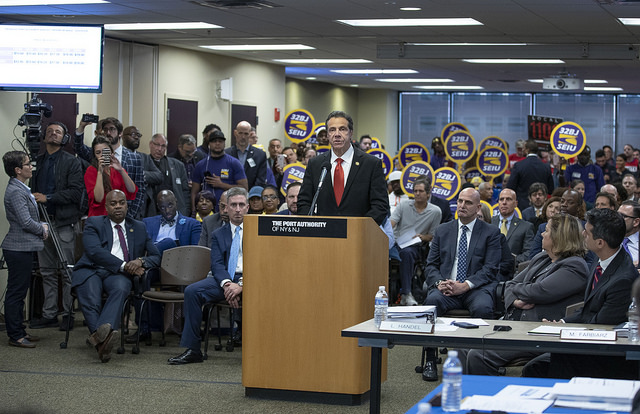
Gov. Cuomo pushes for a higher Port Authority minimum wage (photo: Mike Groll/Governor's Office)
Last week, Governor Cuomo publicly called on Port Authority of New York and New Jersey's Board of Commissioners to pass a higher minimum wage for airport workers. While I, other elected officials, and numerous nonprofit advocates were pleased to see this increase approved, Governor Cuomo has still not fulfilled his commitment to another vital workforce in our state, the human services sector.
Hundreds of thousands of human service employees – the vast majority of whom are contracted by the state – remain unbelievably underpaid, making approximately $23,000-$29,600 per year, with no wage increases since 2010. These rates fall well below the $19 hourly wage the governor called for at the Port Authority, and are also below the average income required to meet the basic living needs of a family. The human services sector is a group comprised of approximately 332,000 New Yorkers – 80% of whom are women, and 50% individuals of color – who provide life changing services to New Yorkers from all walks of life, and are essential to our communities.
These are workers who care for our children, assist those with mental health issues, ensure survivors of domestic violence can rebuild their lives, and care for our aging relatives. Yet they are left with a wage that does not provide economic security of their own. For years, the work of employees in the nonprofit sector has been undervalued; the salaries in the sector are lower than comparable positions in other fields, many of the positions require a college degree but do not compensate accordingly, and stagnant wages result in high turnover.
Not only have state contracts failed to fully fund the wages of these employees, but Governor Cuomo refuses to include common-sense cost of living adjustments (COLA) that would allow these employees to earn a livable wage.
We have fought every single year since Governor Cuomo took office in 2011 for a statutory cost-of-living-adjustment (COLA) for human services employees. To this end, our chief executive has consistently and uncompromisingly deferred from providing any support in this initiative. This inaction has cost the human services workforce almost $500 million in lost wages. We have seen a largely consistent public commitment from the governor in his support of raising wages across New York. This was demonstrated in his remarks last week, in his championing of the $15 minimum wage, and through his outspoken support of pay equity for women. In light of these strong positions, we expect Governor Cuomo to apply this effort to increase the very limited salaries of human service workers.
When this wage increase for Port Authority workers was enacted, the governor stated that “it is paramount that we have a well-trained, secure, stable workforce…Invest in your most important asset, which is your workforce. Fairness, diligence, good business practices all bring one to the same obvious conclusion. Invest in the workforce, raise the minimum wage to $19 over five years. It is the right thing to do. It is the smart thing to do."
We agree, Governor Cuomo. It is time for our state’s leader to make good on his own words, and fund the human services COLA in the next state budget to ensure living wages for this workforce which we our state depends on so heavily in order to build strong communities.
The governor said it best himself: “It is the right thing to do. It is the smart thing to do.”
***
Andrew Hevesi is a member of the New York State Assembly, representing parts of Queens in Assembly District 28. On Twitter @AndrewHevesi.
***
Have an op-ed idea or submission for Gotham Gazette? Email This email address is being protected from spambots. You need JavaScript enabled to view it.
In Keeping Stranglehold, Brooklyn Democratic Party Bosses Further Sow Seeds of Their Demise
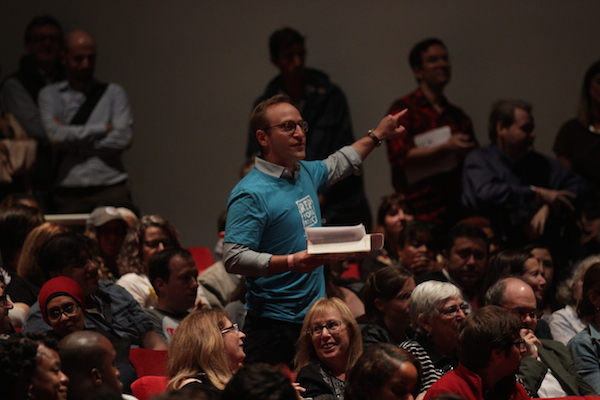
Kings County Democratic Committee meeting (photo: James Boo, New Kings Democrats)
This summer I collected signatures from neighbors to represent my election district, an area of a few blocks, as a member of the Kings County Democratic Committee (KCDC), the Brooklyn denomination of the New York State Democratic Party.
I had signed up with the #RepYourBlock campaign, convened by New Kings Democrats (NKD), one-and-a-half years earlier for this purpose. I handed in my petitions in June and a few months later I received a postcard informing me of KCDC’s bi-annual rules meeting, on September 27 at Kingsborough Community College. This postcard let me know that if I signed and returned it to Frank Seddio, the Democratic County Chair, there would be no need for me to attend. Despite this “helpful” suggestion that I turn over my vote through this proxy before ever even participating in a meeting, I made plans to be there.
The hundreds of people gathered in the Leon M. Goldstein Performing Arts Center on September 27 ranged from newly-minted members like myself to people who had been attending for decades. From the beginning, it was clear that the party leadership was overwhelmed by the turnout. It was less clear whether that was by design or by incompetence.
We waited two-and-a-half hours past the posted start time for the meeting to begin. It was standing room only, and the people around me were palpably excited to participate in this most local form of government. When the meeting finally began, it got off to a contentious start. KCDC members heckled from the back of the room. The person leading the meeting, former State Senator Martin Connor, never introduced himself and was immediately defensive. Many of us had trouble following what was happening in a poorly-mic'd room with a lot of background noise.
In the weeks leading up to the meeting there had been heightening tension around the efforts of NKD, a reform club trying to increase the participation of everyday Brooklynites through the #RepYourBlock campaign. NKD had reached out to Democratic County Committee members encouraging them to attend the meeting and if they couldn’t, asking that they give their proxy to someone they know or one of the #RepYourBlock partners, in an attempt to counter the juggernaut of the party leadership proxy-collection machine. Many committee members received multiple requests for their proxy (a way to allow someone else to vote in your absence), including a misleading one from party leadership that purported to be signed by one’s state Assembly member and district leaders (many of whom claimed this happened without their permission). Partially in response to this, there was a proposal to reform the proxy system introduced by my own Assembly member, Robert Carroll, which was overwhelmingly supported.
Then the time came for the vote that is one of the only real roles for members like me – voting for the officers of the executive committee. This year an actual competitive election was possible, because an alternate “reform” slate had been proposed by #RepYourBlock. The voting began, and an already tense meeting unmistakably changed.
Because we didn’t even get the chance to vote!
It was over before it started. Party leadership had waited to start the meeting until they were sure that Frank Seddio had enough proxy votes to overrule anything that happened. The voting began with a vote on the complete executive committee slate, and motions for a vote on each individual position were overruled or just flat out disregarded. When the vote was called for the establishment slate, about 50 people stood up. Martin Connor said those 50 votes, plus the more than 500 proxies held by Frank Seddio, meant the establishment slate won.
Even when those numbers were questioned, or when it was pointed out that the numbers didn’t seem to add up, or when it was clear that the numbers being reported were actively changing as more proxies appeared with every challenge, we were told “It’s done” and the meeting moved on.
In that room there were hundreds of people like me who had petitioned to be on County Committee, some of whom had competed in primaries. Over 500 people had left work early, skipped dinner, planned for childcare, carpooled, rode a subway to a bus, or made countless other arrangements, all to come to Manhattan Beach on a weeknight and attend a five-hour meeting. And the overwhelming majority were not even able to stand up and be counted in favor of a candidate they supported. Their questions and requests for explanation or clarification were dismissed and they were scolded from the lectern for daring to even ask them.
When a motion was made to recount the vote, after a member pointed out that the numbers given did not add up to an establishment victory, the vote in favor of recount was overwhelming. That vote was also unsuccessful, as Seddio’s proxies still outnumbered those in attendance. But the room had shifted, and even people who had voted for the establishment slate saw what was happening as counter to a democratic process. NKD and #RepYourBlock had inspired us to show up and be a part of our local political process, and the Kings County Democratic Party saw us as an obstacle.
The Brooklyn Democratic Party leadership did more for reform with its actions in that auditorium than years of organizing could have.
It is a testament to the efforts of #RepYourBlock that so many people were there. And by being so entrenched, and so unwilling to allow for anything that might dilute their stranglehold on Brooklyn politics, party leadership ensured that the proxy abuse they are so reliant on is in its final days.
***
Nicole Hunt is a member of New Kings Democrats, on the Executive Committee of Brooklyn Voters Alliance, and a member of the Kings County Democratic Committee. On Twitter @msnicolemh.
***
Have an op-ed idea or submission for Gotham Gazette? Email This email address is being protected from spambots. You need JavaScript enabled to view it.
Discouraged But Determined; Queens County Committee Will Change
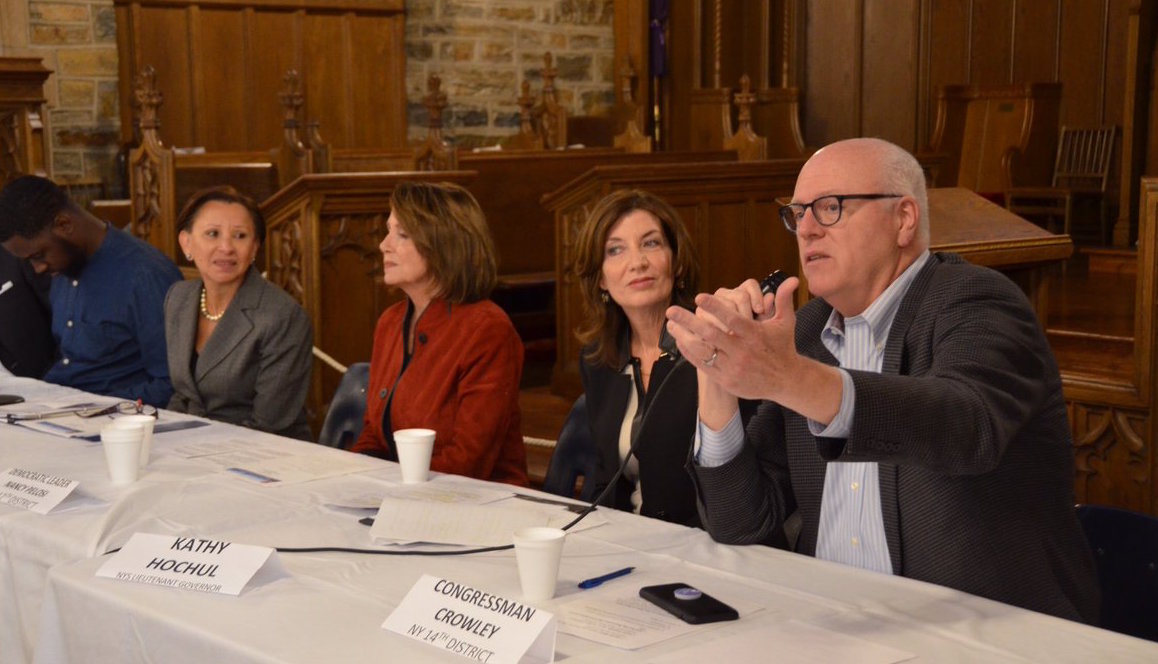
Queens County Democratic leader Joe Crowley (photo: @repjoecrowley)
This summer, the New York Times reported that candidates to become Democratic committee members in Queens were unaware that they were running for office and would be on the September 13 ballot. Queens Democratic Party bosses were nominating candidates without their consent for County Committee membership. You read that right.
Those party bosses, long-term incumbent elected officials also known as establishment Democrats, tried to prevent new, more progressive Democratic candidates from entering these local races. Their preference is, of course, to to maintain the status quo.
As a young Democrat passionate about public service, hearing about this corrupt electoral process happening in my backyard left me feeling discouraged. To live in an equitable society, establishment Democrats need to know not to partake in antiquated, exclusionary practices. In order to have a united Democratic Party there has to be a process where everyone can participate; wherein elections are open, transparent, and inclusive. By nominating candidates without their consent, establishment Democrats not only lose credibility, but they jeopardize the very foundations of our democratic process, the bedrock of our nation. They keep my home borough of Queens from progressing and marginalize people that actually want to get involved.
Many Democratic voters are beginning to support progressive candidates that distance themselves from the current establishment. I think back to the congressional primary win of Alexandria Ocasio-Cortez in June as well as the recent primary wins of progressives at the state level and feel encouraged that new candidates challenging incumbents approach their campaigns through a more just lens. New progressive Democrats are taking a stance that fights for economic, social, and racial justice for all and reject corporate PAC and corporate lobbyist money. This is a message to Democratic Party bosses that Democratic constituents will not wait for establishment incumbents to change unjust systems and practices.
Democrats who are too content with the status quo and sitting down on progressive issues will run the risk of not being reelected. While many establishment Democrats point at Republicans as the ones to blame for failing systems, mismanagement of funds, and the reason for many of the faults in our society, it’s easy to see that establishment Democrats are not much better. It’s time to look inward first. In order for current establishment Democrats to avoid strong primary challengers and continue winning elections against Republicans, they have to make sure that members of their party are engaged, included, and not being shunned by dishonest electoral processes. We need Democrats who ensure elections are just and not being controlled by the party bosses at the top.
Although some establishment Democrats can tout years of experience and successes, if they have not done anything to change the electoral system, or have been too complacent, then many of their efforts are in vain. Winning campaigns through systemic malpractices does not make you an exemplary candidate. As we can see from the recent loss of seven Democratic incumbents in state Senate primaries, establishment Democrats have to be true to their Democratic electorates, take more action to change electoral systems, be more inclusive, and give a voice to more people in their communities. If they fail to do so, constituents from their districts will make sure to elect new progressive Democrats to take their seats.
As an aspiring professional in the field of public service, a Democrat, and a young person wanting to see change, machine politics do not interest me. Though discouraged by the practices of establishment Democrats, I am motivated to get more involved and work to change the unjust systems that currently exist, calling them out, and taking action. I urge my fellow Queens constituents and those around the city to elect the Democratic leaders that are transparent, honest, and committed to electoral integrity, from the local County Committee all the way up.
***
Giovanni Barcenes is an MPA Candidate at the NYU Robert F. Wagner Graduate School of Public Service and lifelong New Yorker born and raised in Queens. On Twitter @GioBarcenes.
***
Have an op-ed idea or submission for Gotham Gazette? Email This email address is being protected from spambots. You need JavaScript enabled to view it.
Immigrant-Service Organizations, Struggling with Immense Demand, Need Our Support
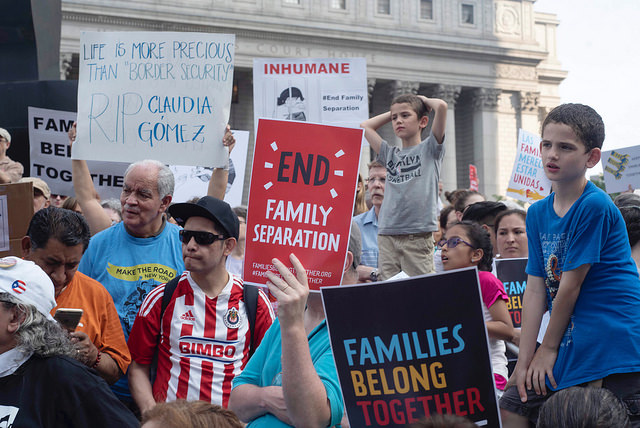
(photo: John McCarten/New York City Council)
The news that immigrants who legally access public benefits, such as food, housing, and medical assistance, could be denied green cards will make it increasingly difficult for many immigrants across our city and nation to meet their basic needs, placing a sizeable burden on the nonprofit sector.
Already, the sector is faced with an unyielding demand for support by families and communities as immigrants turn to nonprofits for support in steeper numbers.
What has become abundantly clear from our work with more than 400 organizations each year that focus on immigration and other social service and advocacy groups is that the current challenges are formidable: nonprofits are doing the best they can despite a national climate of bias and discrimination against immigrants and the groups that serve them.
This increased workload is experienced not only by organizations with an immigrant-serving mission. It is seen by hundreds of the nonprofits we work with each year, from hunger organizations to affordable housing organizations, to those with an educational mission, and countless others.
Amid this climate, Community Resource Exchange recently convened six nonprofit leaders to illustrate the obstacles their staffs and constituents are facing. Speakers, whose work focuses on grassroots organizing, legal support, immigrant youth, economic justice, and LGBTQIA immigrant rights, pointed to issues that are creating a double-bind for nonprofits: increased demand coupled with changes to the system that make delivering services harder.
This the result of multiple factors, including that immigrants already have a heightened fear of being viewed as a public charge when accessing necessary services such as public assistance, Medicaid, and food stamps, for which they are eligible. The proposed change only exacerbates this fear.
This fear is the result of persistent myths that are being exaggerated in the current environment, for instance, that immigrants don’t pay taxes, come to the United States purely dreaming of opportunity (as opposed to fleeing life-threatening conditions in their homelands), and do not contribute to the economy, which have been proved untrue.
Complicating factors have been revisions to information required by the U.S. Citizenship and Immigration Services, amplifying fears of immediate deportation due to things like any accidental errors in completing applications.
Our panelists posed solutions to better serve immigrants: federal and international action to change the reality for immigrants in this country, including the need for a transnational conversation about the treatment of migrants and immigrants not just here in the U.S., but in Europe and other places. Local governments—city and state—and individuals must step in not only with financial help, but with common sense approaches.
Nonprofits need sufficient funding to support increased needs of immigrants coming through their doors, and elected officials who “get it” are those that are on the ground and in the neighborhoods, visibly witnessing the challenges being faced every day.
We must use our voices to seek change. This November 6, Election Day, is one opportunity, when people can support candidates who understand the needs and benefits of our multicultural society—and not just give lip service to secure votes.
Even simply starting a conversation with friends and family—albeit difficult ones—can springboard to broader awareness of the issues surrounding immigration, greater support for nonprofits on the frontlines of serving immigrants, and, most importantly, a better life for immigrants seeking a life in America free from discrimination and fear.
***
Katie Leonberger is the President and CEO of Community Resource Exchange. On Twitter @katieleonberger & @CREinNYC.
***
Have an op-ed idea or submission for Gotham Gazette? Email This email address is being protected from spambots. You need JavaScript enabled to view it.
Fear-mongering Versus Reality in New York Parole
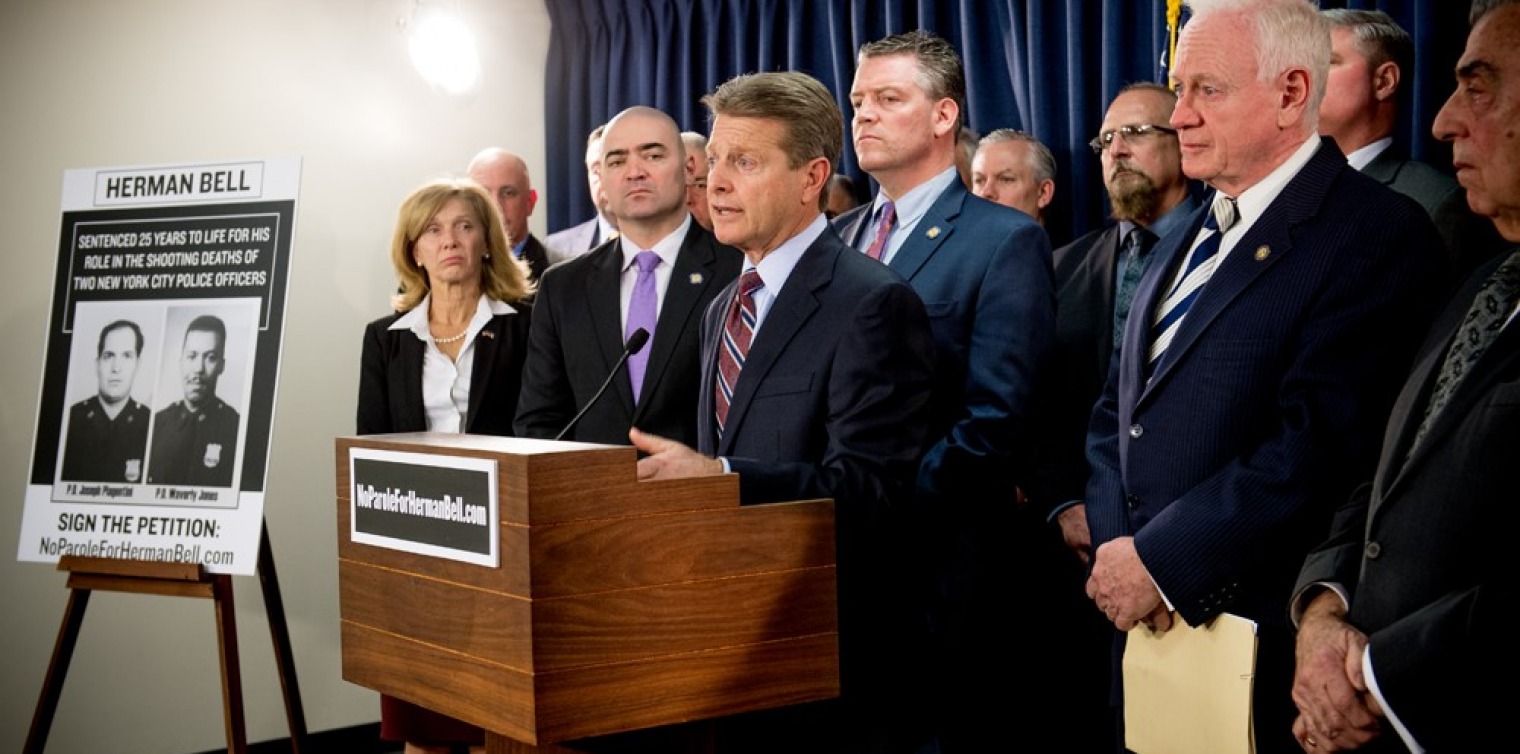
Senate Republicans oppose Herman Bell's parole (photo via Senator Patrick Gallivan's website)
Juxtaposed with the decision by New York State Senate Republicans to hold hearings to voice anger over decisions by the Parole Board was this past Friday’s annual Parole Summit of the Lifers and Longtermers Organization at Otisville Correctional Facility.
Summit attendees, including parole reform advocates, clergy, academics, and a judge from the New York Court of Appeals, heard person after person talk passionately about the Lifers’ commitment to their “Four Rs” of responsibility, remorse, reconciliation, and rehabilitation. By day’s end it was clear that for many people behind bars there is a fifth “R” – redemption.
The transparent political motivation to hold hearings so close in time to elections is made all the more shameful by the appeal to fear-mongering, as comments already circulating by Senate Republicans raise the specter of droves of dangerous criminals randomly turned loose on the streets of Albany and Long Island, the chosen sites for the hearings, and elsewhere.
Senator Patrick Gallivan, Chair of the Crime Victims, Crime and Correction Committee that co-sponsored the hearings, characterizes a select few Board decisions granting parole as “indefensible and an affront to law-abiding citizens.” To the contrary, the Board followed the laws and regulations that govern the Board’s decision-making. Far more troubling to law-abiding citizens is an elected official urging the Board to flout the law.
The Legislature passes laws that set minimum and maximum sentences, and judges mete out sentences pursuant to those laws. A person becomes eligible for parole after they have served their minimum judicially-imposed sentence. The Legislature has enumerated a number of factors that the Parole Board must consider when weighing whether to grant parole. If you have done well while incarcerated -- completed all required programs, avoided serious disciplinary infractions, accepted responsibility for your actions, and made a thorough re-entry plan -- you should be released. That is the law. Indeed, that is what people are told when they are sentenced.
Long-overdue changes to the laws and regulations that govern parole direct the Board to take a forward-looking approach; evaluate who the person is today instead of fixating on the crime of conviction from often decades earlier. Now, the Board is required to utilize an objective evidence-based risk-assessment tool to determine whether someone presents a risk of future violent behavior. Elected officials who suggest that the Parole Board is turning loose a slew of dangerous criminals conveniently ignore that each of these people were deemed to be at the lowest possible risk for re-offending. They also elide the fact that each of these people served decades in prison before they were released. Not only have they been significantly punished, but, according to every study of age and crime, they have long ago “aged out” of any real possibility of future criminal conduct. Put simply, they are profoundly different people at age 50, 60 or 70 than they were when they were in their teens or twenties.
Several Senators also refer disingenuously to the Board’s “seeming automatic releases.” That is patently untrue. The most controversial cases of the past year all involve people who had been denied parole eight, nine, ten, or more times spanning decades. However, consider the recent case of Richard DiGuglielmo. Mr. DiGuglielmo was convicted of murder and sentenced to 20 years to life in a high-profile case involving the killing of a black man by a white off-duty police officer in a dispute over a parking space. Mr. DiGuglielmo served his 20-year minimum and was released at his very first appearance before the Board, a very rare outcome for someone convicted of murder, especially considering the objections from the victim’s family. Notably, there was no outcry from the Republicans members of the Crime Victims, Crime and Correction Committee.
The Board is subjected to relatively little public opprobrium when it chooses to deny parole. Contrary to the claims of Senate Republicans, the far larger problem with the Board, as made abundantly clear at the Otisville Parole Summit, is its habit of routinely denying parole to the many people who have so fully transformed, decisions based solely on the serious nature of the crime of conviction, something the person can never change. These punitive, backward-looking decisions ignore the innate human capacity to change and are ultimately cold and merciless.
The epidemic of mass incarceration is now readily acknowledged. The 130 Lifers and Longtermers at the Otisville Summit have collectively served more than 2,400 years in prison. Many of them have been denied parole repeatedly based exclusively on the crime of conviction from decades before. Contrary to the views of Republican members of the Crime Victims, Crime and Correction Committee, decisions grounded in the extant laws and regulations to grant parole should be praised, not pilloried, and must not be influenced, let alone determined, by who yells the loudest.
***
Steven Zeidman is a professor of law at CUNY School of Law. On Twitter @SteveZeidman.
***
Have an op-ed idea or submission for Gotham Gazette? Email This email address is being protected from spambots. You need JavaScript enabled to view it.
Closing the Door on Foreign Money in New York City Elections
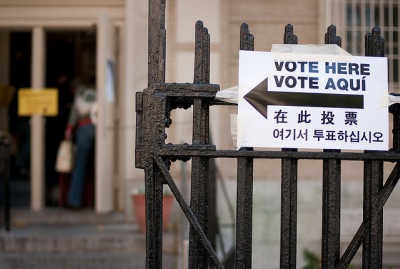
How far and how deep did the Russian government and Russian nationals go to influence United States elections? While hacking and manipulation of social media have garnered significant attention from both the media and the Mueller investigation, it’s also clear that Russian money was being funneled through some surprising channels, such as the National Rifle Association (NRA).
When Citizens United opened the floodgates for corporations to spend unlimited amounts in our elections, it also blasted open a loophole for foreign money to be used to influence U.S. elections. Earlier this month, we collaborated to introduce a bill to close that loophole and keep foreign money out of New York City elections.
While current federal law—affirmed by the Supreme Court in 2012—prohibits foreign governments, foreign-based companies, and people who are not U.S. citizens or permanent residents from contributing or spending money in connection with any federal, state, or local elections, after Citizens United, foreign entities can still invest money through U.S.-based corporations that can then spend as much money as they want on American elections. That’s a direct threat to democracy, and one that our federal government has yet to remedy.
This is not a hypothetical. Companies that we consider to be “American” often have significant foreign investment, and at times that investment comes from some questionable sources. DST Global, for example, has gained notoriety for its Russian connections and has significant investment in many U.S. tech companies, including several iconic companies like Airbnb, Facebook, and Twitter. Saudi Arabia has also been “using its wealth for global influence” with over $2 trillion to invest via its sovereign wealth fund, and it has already taken large stakes in U.S. based companies like Uber, Tesla, and Sprint through its joint tech fund with SoftBank Group, a Japanese company. To be clear, we do not mean to say that these companies are controlled by Russia or Saudi Arabia, but they do serve as examples of how little we know about the foreign ownership of American companies, some of which spend significant amounts trying to influence American politics.
As the U.S. midterm elections approach, foreign actors are testing out new ways to hide their trails. They’ve stopped paying in rubles, and that means that the corporate loophole created by Citizens United will be ever more attractive. The evidence is also mounting that Russia was not alone. Saudi Arabia, the United Arab Emirates, Qatar, and others reportedly sought to put their thumbs on the scale. Though Ellen Weintraub, the vice chair of the Federal Election Commission, has been sounding the alarm about this for years, partisan politics has stopped attempts in Congress and at the Commission to prevent foreign money from being funneled through corporations.
That’s why it is critical to move now to protect our local elections from corrupt foreign influence and to help create a national model for campaign finance reform. In order to protect the integrity of New York City elections, our bill -- Intro. 7087 -- would strengthen the existing federal prohibition on direct foreign and corporate campaign contributions by extending the ban to American corporations under substantial foreign ownership or control.
The bill would prohibit contributions and spending in local elections by “foreign-influenced entities,” which is defined as an entity that is either (1) more than 5 percent owned by a single foreign national, (2) more than 20 percent owned by more than one foreign national, or (3) a corporation in which foreign-national owners call the shots on its political activities. A similar proposal enacted in St. Petersburg, Florida received the backing of constitutional luminaries like Laurence Tribe and Charles Fried, and stands on firm legal ground.
New York has long been a leader in taking action to protect the integrity of its elections and ensure that the voices of New Yorkers are not drowned out by corporate money. New Yorkers deserve to know that foreign money is not flowing into local elections through hard-to-trace corporate channels. This bill upholds the basic principles of American self-government, free from foreign influence. Foreign interference is a clear and present danger, but by closing this gaping loophole New Yorkers can stem the flow of foreign money in their own elections and lead the way for the rest of the nation.
***
Public Advocate Letitia James
John Bonifaz, President, Free Speech For People
Shanna Cleveland, Senior Counsel, Free Speech For People
***
Have an op-ed idea or submission for Gotham Gazette? Email This email address is being protected from spambots. You need JavaScript enabled to view it.
Politics Created NYCHA; Only Politics Will Save It
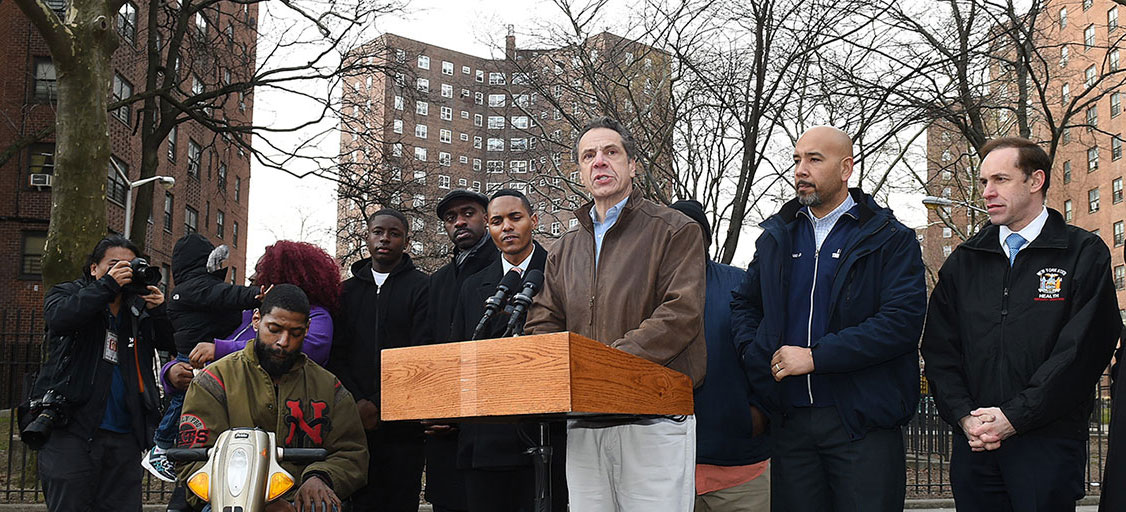
(photo via the Governor's office)
The New York City Housing Authority’s first developments in the 1930s rose from the frustrations of a massive working class tired of sweating and suffering in crappy tenements. NYCHA grew in the decades that followed, to about 175,000 apartments, thanks to consistent support from politicians under tremendous pressure from everyday New Yorkers, housing advocates, and the media.
Politics saved NYCHA multiple times from the fate of public housing in other American cities. The civil rights movement forced NYCHA to desegregate its projects after the 1930s. Outrage over management in the late 1950s led to a sacking of callous leadership handpicked by Robert Moses. New York’s Congressional delegation convinced their colleagues in both the 1970s and 1990s to assume responsibility for tens of thousands of city and state public housing projects.
NYCHA residents, New York politicians, and many advocates, however, failed to adjust fast enough to a new national political reality. The rest of America, including most federal officials overseeing the program, viewed public housing as a dead program by the 1990s -- and treated it as such. Federal officials have since then intentionally refused to fund NYCHA’s capital or operating needs at a level sufficient to maintain the quality of life to which residents had become accustomed.
Frustrated residents for years disconnected from the political process despite the growing threat of aging apartments and buildings. Other affordable housing preservation and development programs took priority for many housing advocates and elected officials. City, federal, and state politicians pointed fingers at each other. The results of disinvestment are on display despite NYCHA apartments remaining full and much desired in New York.
In just a few years of crisis, however, it already seems the wheel is turning. Residents and housing advocates have kept the heat on politicians, feeding a steady stream of heartbreaking images and stories to the media and the courts. Elected officials can’t pick up the paper or turn on the TV without reading about a problem, often in their district. Crisis on an unprecedented scale has forced the issue to the front time and again: Sandy flooding, deep freeze, mold, lead.
Has the result of all this bad press been the abandonment of public housing as in other cities? No. Where bad press led to demolition in other cities, in New York negative attention seems to be leading to a steady and growing flow of money to renovate public housing. Demolition could still happen in New York but knocking down NYCHA is still a third rail of politics here -- and unimaginably complex to boot. We simply don’t have additional homes, short- or long-term, for more than 400,000 poor people.
Already, the totals won for NYCHA are mounting: $3 billion for Sandy reconstruction from FEMA; billions from the city so far and billions more promised (thanks to a consent decree) for roofs, boilers, lead tests, and more; hundreds of millions promised from the state. NYCHA has also quietly done what it can with remaining federal capital funds since the 1990s to stabilize conditions, working from the outside in on building envelope bricks and roofs. NYCHA successfully used the federal RAD program to upgrade housing for thousands of residents now living under private sector management—and plans for thousands of additional apartments in this program are underway.
Renovation of such a big system moves much more slowly than residents want and often fails to address immediate needs in their apartments -- but it is happening. That refitting of public housing is happening at all, rather than demolition, speaks to tenant activism of NYCHA residents and their advocates. When a crisis hit public housing elsewhere, politicians have used a crisis to demolish, not rebuild housing (New Orleans after Katrina, for instance, demolished vast projects).
New York’s public housing movement, however, needs to be creative and flexible in the next steps. Residents and their allies should use their political power to pressure politicians to reform labor unions at NYCHA so tenants get economical and high-quality service. Residents and advocates have given the unions a free pass, but this is a strategic mistake because, without a revolution in the hours, roles, and compensation of NYCHA maintenance and custodial staff (comprising 40 percent of NYCHA’s annual budget), NYCHA residents are not going to enjoy major improvements in their quality of life.
Residents and advocates also need to force the Mayor to come up with a reasonable long-term plan for investment. While an immediate commitment of the estimated $31 billion needed for top-to-bottom renovation is unrealistic, even a lot less can upgrade the quality of life. The city, for instance, needs to integrate NYCHA into its annual capital planning process. Given the growing importance of NYCHA to reducing homelessness, and of infill sites to the city’s affordable housing plans, it only makes sense that NYCHA gets a larger share of city support. Residents should also light a fire under Democratic majorities in Albany and the Governor to find money for additional renovation and public-private partnerships.
NYCHA remains a crucial service for many New Yorkers and one that helps preserve diverse neighborhoods in the face of gentrification. And just because a housing system delivers a product that many people wouldn’t choose for themselves doesn’t mean it isn’t valuable to lots of other people with fewer choices or different values. Mass services like public housing, public transit, and public education will always “lose” money because the people who need and use them generally lack the money to pay the real cost of running a complex urban service whether it be for a subsidized apartment, a subway ride, or a public classroom. It is, however, up to the recipients of these systems to use the political system to secure and protect these essential services.
***
Nicholas Dagen Bloom is a professor at New York Institute of Technology and author of many books.
***
Have an op-ed idea or submission for Gotham Gazette? Email This email address is being protected from spambots. You need JavaScript enabled to view it.
Can Democrats win the state Senate? How progressive is Cuomo? New Yorkers are about to find out
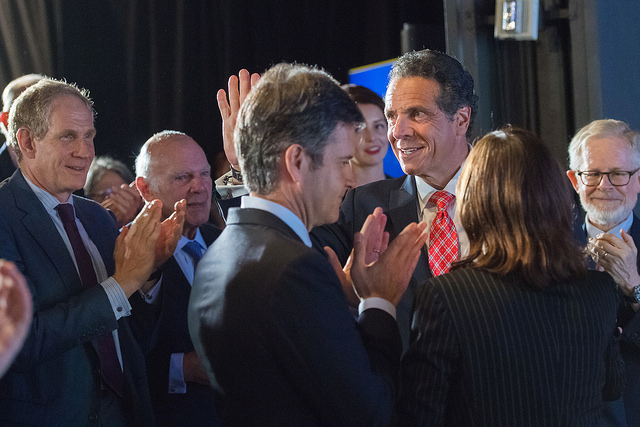
Gov. Cuomo (photo via the Governor's office)
In the November 6 general election, New York Democrats have a historic opportunity to take control of the state Senate. If this happens, Democrats would control both houses of the state Legislature for only the third time in the last 100 years, unlocking years of bottled up progressive legislation passed by the Democratically-controlled Assembly but blocked by the Republican-controlled Senate.
Assuming Governor Andrew Cuomo, a Democrat, wins reelection as he is expected to, a number of these bills may very well land on his desk, including those related to universal health care; election, voting and campaign finance reforms; reproductive health rights; equal education funding for city schools; equal protections for LGBT and disabled people; carbon emissions elimination; immigration protections, including making New York a sanctuary state; and criminal justice reforms.
Recent history should temper optimism, however. New York Democratic voters chose the status quo over the bold reforms represented by the Cynthia Nixon-Jumaane Williams-Zephyr Teachout ticket in September’s primaries and in last year’s constitutional convention ballot referendum. In the 2016 state Senate races, 98% of incumbents were re-elected, though one good sign for Democrats in their quest to take over the chamber is the handful of retirements in the GOP conference.
We’ll soon see how powerful New York’s blue wave really is, both on Election Day and in the legislative session that will follow beginning in January. A few key questions:
But didn’t progressives just defeat the IDC?
Sort of and it’s insufficient.
Before the primary, there were actually more “Democrats” in the state Senate than Republicans, even though the GOP conference held a 40-23, then 32-31 majority in the 63-seat chamber.
Nine Democrats were either part of the Republican conference or in a power-sharing agreement via the Independent Democratic Conference (IDC), giving the GOP a majority for the recent two-year legislative session (and prior) and preventing progressive legislation from reaching the Senate floor. Eight of those senators were members of the IDC, which did rejoin the “mainline” Democratic conference in April, after a new state budget had been passed, which led to the 32-31 GOP majority for the final months of the session that ended in June.
In the September 13 primary, six former IDC members were defeated. The ninth rogue Democrat, Senator Simcha Felder of Brooklyn, has been part of the Republican Conference for multiple terms, and was even reelected in 2016 on both the Democratic and Republican ballot lines. He won his primary challenge last month.
Despite losing in the Democratic primary, all six defeated former IDC members are likely to remain on November’s ballot on other party lines, often the Independence Party and/or Women’s Equality Party. There’s no guarantee they won’t actively campaign if for no other reason than as spoilers, though most appear unlikely to do so. Democratic leaders may try to reward defeated IDC members -- like former conference leader Senator Jeff Klein and Senator Jesse Hamilton -- with judgeships to keep them from actively campaigning. Klein, along with Senators Jesse Hamilton and Tony Avella, is one of three former IDC members who were defeated in the primary and have not yet declared that they won’t campaign in the general.
Surviving former IDC Senators David Carlucci and Diane Savino, along with Felder, will almost certainly win re-election in November.
What do Democrats really need to do?
Net one seat. If Democrats flip just one GOP-held Senate seat and hold onto those they currently have, then Democrats will have a real 32-31 majority heading into next year. Competitive Senate races exist on Long Island and upstate, including several districts where Democrats failed to run any candidate at all in 2016. There’s also a seat in Southern Brooklyn that represents why many GOP-held districts are vulnerable.
Since 2012, when incumbent Republican Senator Marty Golden won his last competitive race, the district’s demographics have changed dramatically. Today, 40% of residents are now people of color, especially Asian and Hispanic; and 43% are immigrants, primarily Asian, eastern European and Mexican. Residents work in blue collar industries like transportation, wholesale, and construction. Virtually every racial group earns less than the median for New York State. These changes create the setting for the red-to-blue opportunity for progressive Democrat Andrew Gounardes, Golden’s opponent in 2012.
What’s possible?
Flipping nine seats. My most optimistic scenario has Democrats flipping nine GOP-held seats for a 40-23 majority.
If the primaries were any indicator, November turnout will be high, which will benefit Democrats due to their two-to-one registration advantage across the state. Primary turnout more than doubled since the last comparable election in 2014. In Long Island’s Nassau and Suffolk counties, Democratic primary turnout actually tripled from 2014 to this year.
Democrats are mounting competitive races in the five GOP-held districts where the current officeholder is retiring. In 2012, Obama carried all of those districts; In 2016, Clinton carried one and Trump won by 6% or less in the other four. Democrats are also contesting several other races where the Republican officeholder is seen as beatable.
Here is my list for the best opportunities for Democrats to flip GOP-held Senate seats. In compiling this list, I considered voting results by state Senate in the two most recent presidential elections, fundraising, the power of incumbency and signals of grassroots support.

Past voter preferences matter. The 2012 presidential election was more reflective of deeply felt beliefs in these districts, which had with one exception solid pluralities for Obama. Democratic voters who stayed home may have contributed to the mixed results of the 2016 election. By this year, 2016’s GOP victories didn’t deter -- and perhaps motivated -- Democratic contributors and may have awakened Democrats who came out in droves to vote in this year’s primary. In addition, changing demographics have also affected these districts in ways that potentially favor progressive Democratic candidates.
Money matters -- to pay for campaign staff, advertising, get-out-the-vote efforts, and more. The table above includes the most recent Board of Elections campaign disclosures, filed by September 24, and showing money in the bank as of the filing. Some candidates benefited from the lack of a primary, which means they have more funds for the general election, but may not have benefited from public exposure without opposition.
The New York Daily News reports that Cuomo intends to fund-raise for several Senate candidates, including Gounardes, D’Amaro, Kaplan, Skoufis, Smythe, and Metzger. The two other Democratic candidates mentioned in the Daily News story -- Monica Martinez in SD-3 and Pete Harckham in SD-40 -- don’t appear to be currently competitive based on funds raised and the lack of time before Election Day.
Aren’t there Democrats at risk?
Incumbent Democrats largely appear safe. John Brooks in Senate District 8 on Long Island is often mentioned as a potential risk, probably due to his narrow 214-vote (0.2%) win in 2016 over then-incumbent GOP Senator Michael Venditto. But now-incumbent Brooks has a solid fundraising lead over the current GOP candidate, Jeff Pravato, in a district that went for Hillary Clinton and Obama and has a solid Democratic voter registration advantage.
Democrats need to ensure that primary victors Rachel May in SD-53 and Alessandra Biaggi in SD-34, both of whom beat IDC members, continue their momentum through November. The IDC incumbents they defeated are likely to appear on other ballot lines and have significant money. May’s opponent, David Valesky, reported $340,038 post-primary to May’s $41,209, though he has recently declared that he will not campaign in the general.
Biaggi’s opponent, former IDC leader Klein, reported $957,827 just before the primary to Biaggi’s post-primary balance of $172,909. As of this writing, Klein’s post-primary filing still hadn’t been published and he had not indicated his general election plans.
So what’s going to happen?
On November 6, Democrats will take control of the New York State Senate with a solid majority that Republicans cannot hold back. This, along with holding onto a wide majority in the Assembly, will likely result in a steady stream of progressive legislation on the governor’s desk to sign, giving Cuomo the opportunity to make history New York has been waiting for.
***
Art Chang is a writer, thinker and strategist at the intersection of technology and government. He is a former board member of New York City’s Campaign Finance Board, where he led the creation of NYC Votes and Voting.NYC. On Twitter @achangnyc.
***
Have an op-ed idea or submission for Gotham Gazette? Email This email address is being protected from spambots. You need JavaScript enabled to view it.
Doing the Mass Bail Out the Right Way
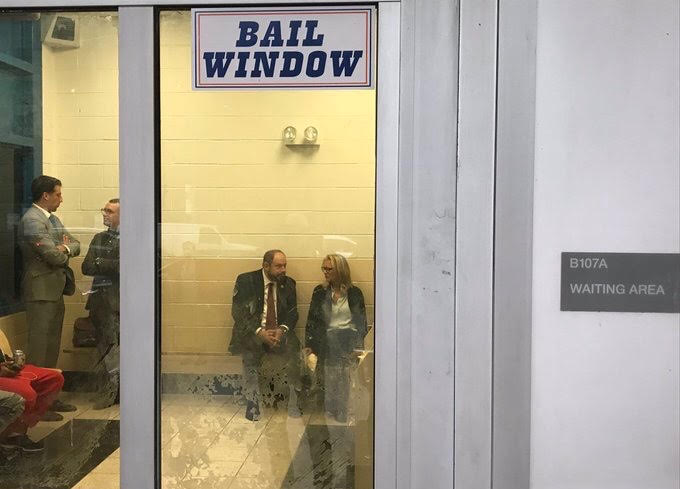
(photo via @RoryLancman)
The Robert F. Kennedy Human Rights Foundation’s just-launched “mass bail out” -- which could release from New York City jails 500 incarcerated indigent young and women defendants charged with misdemeanors and violent felonies -- is a good plan if it is implemented responsibly.
The plan dramatically highlights the bail system’s glaring inequities, as thousands sit in jail for months, unable to pay bail.
Not surprisingly, the plan has caused an immediate and strong reaction, particularly from the NYPD.
NYPD Commissioner James O’Neill warned of an oncoming crime wave if the Foundation’s bailed defendants are released, claiming it will make New York City “less safe.” He also decried, “What about the victims? What about witness intimidation? What about retaliation?” New York City’s district attorneys have sided with O’Neill; though oddly, they remain some of the biggest supporters of bail reform.
The fear is that newly bailed defendants will start a crime wave even though no crime wave was ever started by those with the financial resources to make bail. In fact, most defendants on bail return for their court date.
This unfounded fear only underscores the economic disparity in our court system and is inconsistent with justice and with New York state law.
Bail is set at arraignment: the prosecutor and defense attorney are heard, then a judge applies the statutory criteria for setting bail, including considering the main standard: will a defendant return to court for his or her case.
Perhaps defensively, the Foundation’s president mistakenly stated, “If a judge feels this person is a danger to society, they will not make them bail eligible.” New York does not have a pre-trial detention bail criteria. However, federal law specifically permits pre-trial detention if “such person poses a danger to any other person or the community.”
It also demonstrates just how tricky ending bail inequity is.
But, before the Foundation and its partners can implement their program they must have a dialogue with the city’s district attorneys regarding their bail policies and concerns.
Before posting bail the advocates must consider why bail was set by a judge and ensure a potentially released defendant meets any conditions, such as not contacting a victim or witness and attending future court appearances. After all, this plan places the Foundation in the place of a family member who would normally put up bail and suffers a financial hardship if a defendant skips court. This means the Foundation will also have to supervise the defendant while on bail.
The Foundation and partners must also comply with existing bail laws, which restrict depositing bail for multiple defendants. Among other things, New York State’s Superintendent of Insurance must authorize a certificate for the Foundation to become a “charitable bail organization.”
Other opportunities for bail reform dialogue also exist.
For instance, a reform must include fast tracking incarcerated young defendants’ cases to disposition.
Encouraging the NYPD to issue Desk Appearance Tickets (DATs) for all misdemeanor arrests and seeking statutory authority to issue DATs for nonviolent low-level felony arrests. A DAT releases an accused with a future court date at the station house without waiting 18-24 hours in custody for arraignment.
There must be greater use of existing non-cash bail alternatives permitted under New York law, eliminating costly bail bonds.
The Foundation’s program – if successful – is a significant step forward for criminal justice and bail reform. After more than 20 years of stop-and-frisk excesses, broken windows arrests, and inequitable bail practices, economic disparity must end for the many who are incarcerated in our city’s jails waiting inordinately for their day in court.
***
Arnold N. Kriss is an attorney in private practice in Manhattan, and a former NYPD Deputy Commissioner for Trials and Brooklyn Assistant District Attorney. On Twitter @ArnieKriss.
***
Have an op-ed idea or submission for Gotham Gazette? Email This email address is being protected from spambots. You need JavaScript enabled to view it.
Show the Lefkowitz Some Love
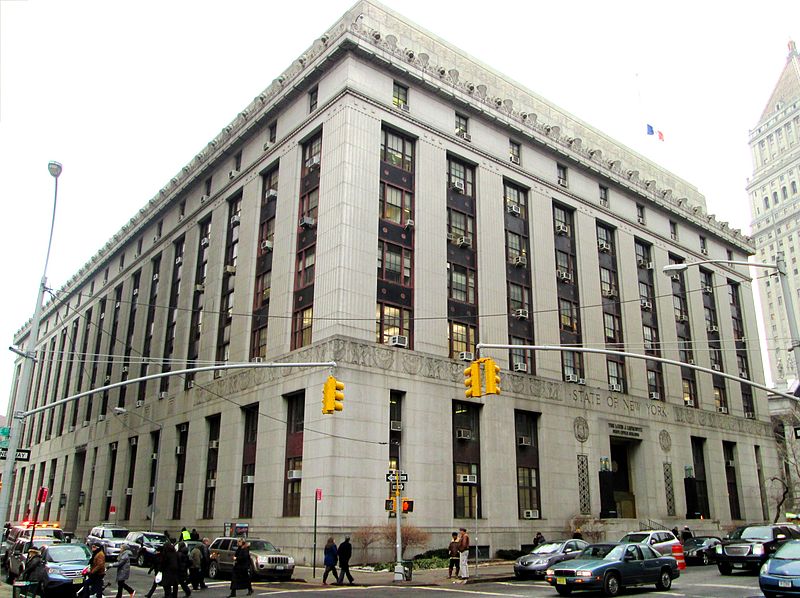
The Lefkowitz Building (photo: Beyond My Ken via Wikimedia Commons)
For nearly a decade, lovers have flocked to Lower Manhattan’s magnificent Louis Lefkowitz Building.
Why, you ask?
The handsome Lefkowitz is home to the Manhattan Marriage Bureau. Each year, thousands of couples climb its distinctive stone stairs, pass under its carved eagle friezes, and enter its ornate inner lobbies to make their affection official.
The Lefkowitz is especially beloved by LGBT New Yorkers. A whopping 293 newly-eligible pairs wed there on the first day same-sex marriage became legal.
“Getting married in a place with such historical significance made me feel like I was a part of something,” explained Sarah Factor, who tied the knot at the Lefkowitz with her wife Julie Mayrin shortly after marriage equality passed in New York.
“When we were finally able to marry, we came to the Lefkowitz,” added Mayrin, matter-of-factly. “Going up those stairs was symbolic for me as a native New Yorker.”
But the Lefkowitz now needs a little love of its own.
Though marriage is supposed to be forever, Mayor de Blasio wants to give this temple of love an ugly divorce. De Blasio plans to gut – or even demolish – the beloved Lefkowitz to build a more humane jail for those facing trial in Manhattan.
As Mayrin sees it, the mayor’s plan would “destroy a monument.” And neighbors, elected officials, and concerned New Yorkers are beginning to agree.
Mass incarceration is among our society’s greatest sins, and de Blasio is correct to upend an intolerable status quo. With its large floor plates, outdated upper offices, and proximity to the criminal courts, it would be smart and simple to reuse certain parts of the Lefkowitz for pre-trial detention.
The Mayor can do all of this without evicting soon-to-be newlyweds and destroying a deeply admired New York structure. All it takes are a few vows from city officials.
First, the Landmarks Preservation Commission should protect the Lefkowitz’s façades, roofline, and first-floor public interiors. The City Council should then step up to the altar and pass legislation ensuring marriages remain in their rightful place for good.
None of this will happen without your help. Call, write, or visit the mayor, Landmarks Commission, and City Council – and demand they protect the Lefkowitz “till death do us part.”
***
Adrian Untermyer is an urbanist who advocates for historic preservation and improved transportation in Greater New York and nationwide. On Twitter @Untermyer.
***
Have an op-ed idea or submission for Gotham Gazette? Email This email address is being protected from spambots. You need JavaScript enabled to view it.